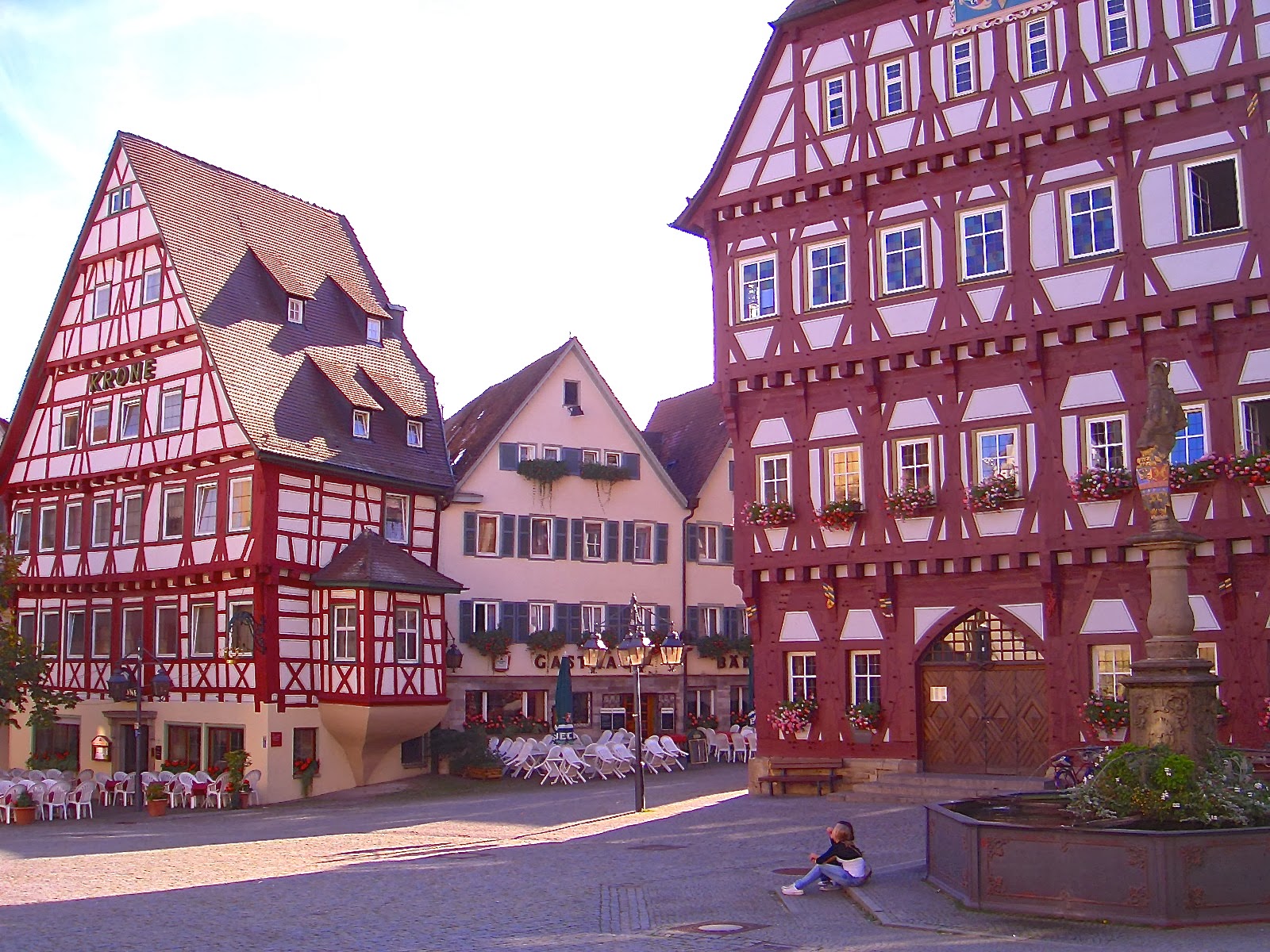 |
| Markgröningen's main square in the late afternoon sun. |
My visit to Markgröningen was a short one as I was there on business, so I regret that I don't have a lot of photos or stories to tell you about this very interesting town. Still, I wanted to post this because it is definitely an interesting place with a very unique tradition - the Schäferlauf. I'll tell you more about that further down. First, a little something about this historically unique town.
 |
| Bartholomäuskirche, Markgröningen (Bartholomew's Church) |
Evidently, Markgröningen was originally known as Gruoninga when it was first mentioned in a deed in 779. This deed was a gift (from whom, I don't know) to the Monastery of Fulda, which is today the seat of the Archbishop of Fulda, yet another beautiful city worth visiting which is located in the center of the German state of Hessen. Later, Mark (meaning: border region, particularly of an area of defence) was added to the name to denote its location at the time between the Alemannisch (today, roughly the area of western Baden-Württemberg running along the French border down into the Basel area of Switzerland) and Frankish (basically in what is today northern Bavaria, parts of Baden-Württemberg, Hessen and also Thuringia) territories.
 |
| A view through the main square toward the Bartholomäuskirche |
 |
| Marktplatz Just look at that house. Doesn't it look a bit top heavy? Looks like you can just give it a good push and it will fall right over. It has been there a very long time. |
Following the Reformation, Markgröningen became Protestant. Its Spital (can be a hospital for the poor or a wayside shelter for pilgrims; the word is also used for "hospital" in Switzerland and Austria today), which was established in 1297 and run by the Catholic Order of the Holy Spirit, was taken over by the city in 1552 and has been administered by it ever since.
Okay, so I said earlier that I would tell you a little about the shephards' run, or Schäferlauf. I do wish I had photos to show you, but I don't. You will have to see it for yourself and make your own photos. Fortunately, if you are in the area, you still have time to get there because it will be held August 22 - 25 this year. As of this posting, that is only a few weeks away!
So what is it? It is a barefoot race through what is called a Stoppelfeld (field of stubble). Sounds like it would hurt. Anyway, young girls race each other for the coveted crown and title of queen, and the boys do the same for the king's crown. And what else do each of their majesties receive? Well, something that all kings and queens covet, of course. A sheep!
This has been going on in Markgröningen since about 1445. (They ought to be pretty good at it by now, I would think.) The event has turned into a three-day festival with a period costume-filled parade, church service and demonstrations of the various tasks of shepherds. Yes, there are even sheep. Surprised? Although I have yet to see the actual event, I have only heard that it is indeed worth meandering through and experiencing.
I do wish I had more photos to show you. Hopefully the few I have here will at least whet your appetite enough to at least do some research on your own via the internet. Don't just look at Wikipedia. Go to other sites, or click here and find more online photos of the actual Schäferlauf on Google.
 |
| Der obere Torturm (Upper gate tower) This is the last remaining of the four gates into the city of Markgröningen when a wall surrounded it. The wall was dismantled before 1850. |
How to get to Markgröningen by public transportation: From Stuttgart Hauptbahnhof (main station), take the S5 (underground platform) to Asperg (another interesting town with a castle above it). This takes about 18-20 minutes. From there, go out to the front of the station and catch the no. 532 bus in the direction of "Mühlstraße Oberriexingen". Ask the driver to tell you when you have arrived because the old town is not where he drops you off. I don't believe any buses go through that part of town, but it is merely a couple of blocks away. Remember where you got off, because you will need to come back to that spot to return to Stuttgart. Altogether, the trip from Stuttgart should take you about 35 minutes.
By car? Hmm, I don't travel that way, so I can't tell you, but I would assume streets and perhaps a highway or two might be a good idea ;-). Otherwise, I think most of you who drive have a navigator, so enter "Markgröningen" or "Markgroeningen", and any of the options that come up will get you there.









